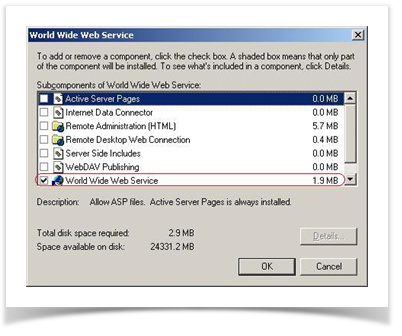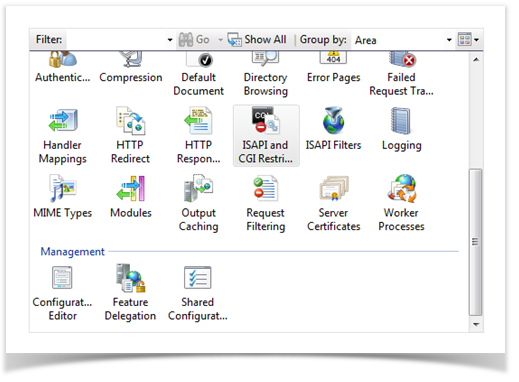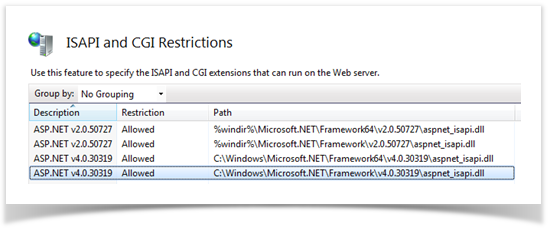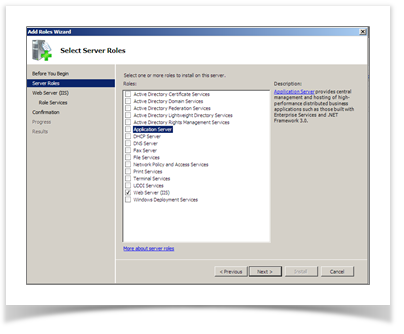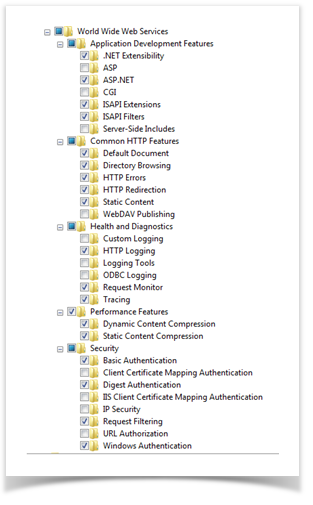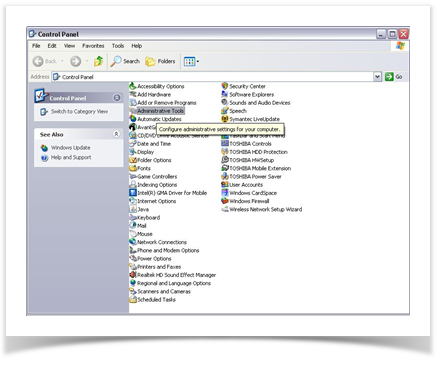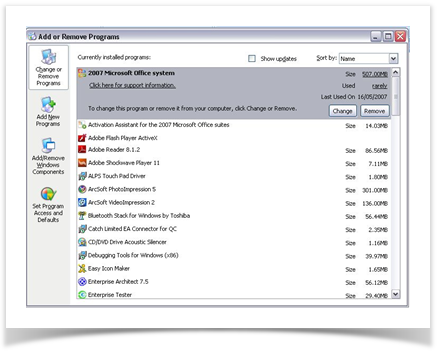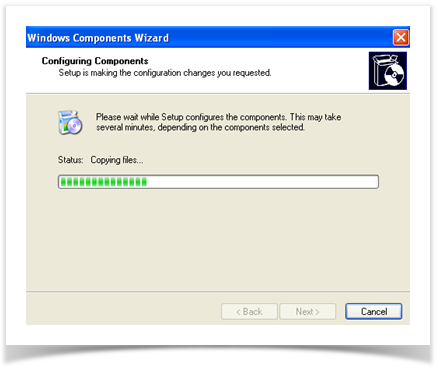Before installing Enterprise Tester, Internet Information Services and ASP.Net must be installed and configured.
Windows Server 2003
Verify ASP.Net Is Installed
From the Control Panel -> Add / Remove Programs, click "Add / Remove Windows Components". Highlight the "Application Server" listing, and click "Details...".
Check that "ASP.NET" is installed.
Verify IIS Is Installed
Staying within the "Add / Remove Windows Components" and "Application Server", scroll to "Internet Information Services".
Highlight this item, and click "Details...". Highlight, "World Wide Web Service" and then click "Details...".
Check that "World Wide Web Service" is installed.
Verify IIS Configuration
Once you have verified steps 1 and 2, you must make sure IIS is configured to allow ASP.Net pages to be processed.
Start up the IIS Manager (Click Start -> Run and type %windir%\system32\inetsrv\iis.msc. click OK ). Expand the server, and highlight "Web Service Extensions".
For XP and Windows 2003r2:
For Vista, Windows 7, Windows 2008 r2:
Check that ASP.Net is allowed.
| Table of Contents |
|---|
Install IIS prerequisites automatically with Powershell
Below we have provided powershell commands to automatically install the Enterprise Tester IIS prerequisites. Each command should be a single line and run from an elevated command prompt. (These commands just automatically install the required packages which the screen shots show being installed below).
Windows Server 2008 R2
| Note |
|---|
You may need to run the following command: import-module servermanager |
| Code Block |
|---|
Add-WindowsFeature Web-App-Dev,Web-Asp-Net,Web-Basic-Auth,Web-Common-Http,Web-Default-Doc,Web-Dir-Browsing,Web-Dyn-Compression,Web-Filtering,Web-Health,Web-Http-Errors,Web-Http-Logging,Web-Http-Redirect,Web-Http-Tracing,Web-ISAPI-Ext,Web-ISAPI-Filter,Web-Metabase,Web-Mgmt-Console,Web-Mgmt-Service,Web-Mgmt-Tools,Web-Net-Ext,Web-Performance,Web-Request-Monitor,Web-Scripting-Tools,Web-Security,Web-Server,Web-Stat-Compression,Web-Static-Content,Web-WebServer,Web-Windows-Auth |
Windows Server 2012
| Code Block |
|---|
Add-WindowsFeature NET-Framework-45-Core,NET-Framework-45-ASPNET,Web-Default-Doc,Web-Dir-Browsing,Web-Http-Errors,Web-Static-Content,Web-Http-Redirect,Web-Http-Logging,Web-Http-Tracing,Web-Stat-Compression,Web-Dyn-Compression,Web-Filtering,Web-Net-Ext,Web-Net-Ext45,Web-AppInit,Web-Asp-Net,Web-Asp-Net45,Web-ISAPI-Ext,Web-ISAPI-Filter,Web-WebSockets,Web-Mgmt-Console,Web-Scripting-Tools,Web-Basic-Auth,Web-Windows-Auth |
Windows Server 2008 - Manual Configuration
...
1. Click start -> Server Manage
Click roles
Click Add Roles
Click Web Server (IIS)
Click on ‘Next’.
If prompted for Add features required for Web Server (IIS) then click "Add required features".
Click ‘Role Services’.
2. Enable the services as shown in the following two screen shots.
3. Once complete click ’Next’, installation will proceed - once the progress bar is complete IIS has been installed correctly.
4. Close the dialog and proceed with executing the installation for Enterprise Tester to install the other prerequisites.
Windows 7
...
- Manual Configuration
Configuring IIS on Windows 7 or Vista is is similar the configuration for Windows Server 2008. Note that there is no server management console. You can find more information on configuring IIS here: http://www.ironspeed.com/designer/6.0.0/webhelp/Part_VI/Configuring_IIS_on_Microsoft_Vista.htm
Windows XP
You need to have administrator access to the machine to install IIS on XP.
Select Start -> Control Panel.
Select Add or Remove Programs.
Select Add Windows Components
Select Internet Information Services (IIS) - the service will now be installed for you.
You may be prompted to insert the installation disk, do so if prompted.
...
Review and Configure Window Features
- Go to Control Panel>Programs> Turn Windows Features On and Off.
- Expand Internet Information Services.
- Under Web Management Tools, check that IIS 6 Management Compatibility and IIS Management Console are selected
- Under World Wide Web Services, ensure that .Net Extensibility, Asp.Net are selected.
- Under Common HTTP Features, ensure that Default Document, Directory Browsing, HTTP Errors, HTTP Redirection and Static Content are selected. Ensure that WebDAV Publishing is not selected (this is a common cause of 504 errors).
- Under Security Ensure that Basic Authentication and Windows Authentication are selected.
- Now navigate to Control Panel> Systems and Security>Administrative Tools>IIS Manager> Application pools.
- Right click on the DefaultAppPool, and select "Advanced Settings." A Dialog will appear with settings for the application pool, scroll down until you find the Setting for "Identity", if it is not "Network Service" you will need to update the value to be "Network Service".
| Info |
|---|
If you are installing to a 64 bit operating system, and you intend to integrate Enterprise Tester with SparxSystems Enterprise Architect, and wish to be able to import data from Enterprise Architect EAP files – then you will also need to enable support for 32bit applications in the application pool. |
| Info |
|---|
By default, Enterprise Tester uses Network Service as the identity of the application pool. We recommend that you run the application pool under another service account especially when making use of features such as EA integration or when using Duette to import automated test results for the file system. In addition, when using Windows authentication with SQL Server, you will need to configure the application pool to run under a specific windows account for this feature to work (and give that account access to the ET database within sql server)SQL server). |
Check that ASP.Net is allowed.
Once the above steps are complete you are ready to install Enterprise Tester. See Application Installation for more details.

